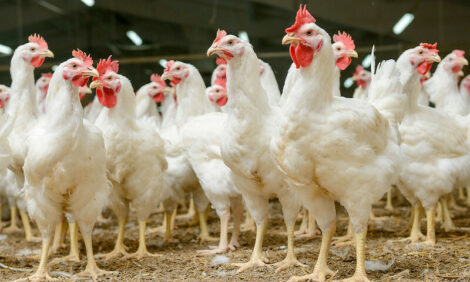



Q2 Poultry Prices Forecast to Remain Strong
GLOBAL - Poultry prices are forecast to remain strong in the second and third quarters of 2012 as a result of high demand and price support from high beef prices. However, due to unfavourable weather conditions in South America, input prices are expected to rise, leading to pressure of margins in the months to come.Recent releases in the US have shown consecutive margin improvement for chicken trade companies, wherein positive margins since late 2011 have been indicated. The March cold storage data offered promising prospects for future chicken prices. Chicken companies have made tremendous progress in the improvement of risk management. Overall, cold storage data, strong exports and improved risk-sharing present promising prospects.
Poultry production in Mexico closed 2011 at historically high levels. Last year, per capita poultry consumption rose by 2 per cent. This growth is in part due to a replacement of pig meat by poultry. Mexico's 2012 poultry meat demand is expected to grow marginally. In the first quarter of 2012, poultry production rose 1.9 per cent compared to the same period last year. Mexico's entry into the second quarter appears tricky due to high grain prices because of the drought, although production appears strong.
During the first quarter of 2012, Brazil's poultry market was marked by an imbalance between supply and demand. Taking the seasonal pattern into account, this led to lower-than-expected poultry prices. For the second and third quarters, a more balanced market is expected. An increase in the number of companies authorised to export to China and a recovery in demand from foreign markets, particularly the Middle East, are also expected.
In 2011, Argentina's poultry production rose 12 per cent year-on-year. Poultry consumption is forecast to continue at current high levels as economic growth decelerates. 2012 expects to see increases in poultry prices as subsidies get eliminated. Companies' profitability will depend largely on the ability to pass higher costs on to consumers.
The Chilean poultry production increased by close to 11 per cent in 2011. Imports of frozen chicken quarters and boneless breasts from the United States rose 75 per cent compared to 2010. There have been allegations made by Chile's Public Prosecutor's Office that the poultry industry was fixing prices.
Throughout 2012, the EU poultry industry is likely to benefit from stronger market principles. Poultry demand appears strong and a modest downturn in feed costs seems possible. The outlook for 2012 poultry exports appears positive. One concern associated with demand is Europe's current economic situation. It is feared that a weaker economy may lead consumers to trade down to poultry meat as the cheapest source of protein, or it could result in reduced demand as buyers consume less protein. Recently, new quotas for further processed chicken and duck were negotiated. As a result, a slight increase in the access to EU market for Thailand and Brazil is expected in the coming years.
In Russia, poultry production is expected to follow last year's pattern in the coming quarters. Growth is expected to continue into the next year with new projects in the pipeline. Market prices have been steady in recent months. Russia is striving to increase exports. According to recent figures, volumes have started to grow mainly to neighbouring countries.
In 2011, China's poultry sector showed excellent performance with an increased production of 5 per cent year-on-year. Profitability is expected to be influenced by a decline in farmgate prices and high cost of raw materials. Poultry demand is also expected to remain high in 2012 owing to rapid growth in fast food and foodservice channels driving greater demand for poultry meat. The Chinese market will continue to provide great potential for leading companies in further expansion. Because of factors such as market consolidation and competition, smaller players will continue to leave the market.
Currently, Japan's poultry inventories are at historically high levels. This is a sign that the country's buying activity will be a little lower in the first half of this year. On the domestic front, market conditions are expected to remain solid. The Japanese industry is expected to rebound from last year's drop in consumption.
Thailand's poultry industry achieved it's 2003 production level of 1.3 million tonnes in 2011. A 3 per cent growth in domestic demand has been forecast for 2012. Japan is once again Thailand's major export destination. It is expected that the upcoming return of Thailand as a raw chicken exported to the EU, and most likely Japan, will result in a new growth outlet in the years to come.
In spite of the avian influenza outbreaks in North East India in February 2012, prices have gradually increased due to high poultry mortality rates reported in the same month. This resulted in a decline in the availability of poultry meat. India's leading poultry company, Suguna, is planning on expanding its branded retail format, Suguna Fresh, from 85 to 500 stores through franchises.
South Korea's poultry consumption is ever-increasing. Broiler demand in 2012 is expected to reach between 770 million tonnes and 780 million tonnes, based on 2011 figures. Import volume could stay below the 100,000 tonne level, probably at 85,000 to 90,000 tonnes.








